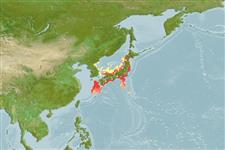>
Gadiformes (Cods) >
Macrouridae (Grenadiers or rattails)
Etymology: Coelorinchus: Greek, koilos = a hollow + Greek, rhyngchos = jaw (Ref. 45335).
More on author: Günther.
Environment: milieu / climate zone / depth range / distribution range
Écologie
marin bathydémersal; non migrateur; profondeur 235 - 830 m (Ref. 1371). Deep-water; 43°N - 28°N, 127°E - 147°E (Ref. 1371)
Northwest Pacific: Japan (Okinawa Trough, Pacific coast southward from Hokkaido), East China Sea (off Kagoshima Prefecture), Sea of Okhotsk and Korea (off Ulsan, Gyeongsangnam-do).
Taille / Poids / Âge
Maturity: Lm ? range ? - ? cm
Max length : 68.0 cm TL mâle / non sexé; (Ref. 1371)
Description synthétique
Morphologie | Morphométrie
Épines dorsales (Total): 0; Épines anales 0. Head large; the eyes also large; head ridges well developed; the snout tipped with a blunt tubercular scute. Scales covered with short, rather broad spinules, arranged in 4 to 9 widely divergent rows. Overall color brownish, bluish ventrally on belly; the mouth and gill cavities blackish, but the latter with whitish hyoid area along its posterior margin; the fins dusky or blackish.
Feeds mainly on euphausiids, prawns, and small fishes (e.g. myctophids).
Life cycle and mating behavior
Maturité | Reproduction | Frai | Œufs | Fécondité | Larves
Cohen, D.M., T. Inada, T. Iwamoto and N. Scialabba, 1990. FAO species catalogue. Vol. 10. Gadiform fishes of the world (Order Gadiformes). An annotated and illustrated catalogue of cods, hakes, grenadiers and other gadiform fishes known to date. FAO Fish. Synop. 125(10). Rome: FAO. 442 p. (Ref. 1371)
Statut dans la liste rouge de l'IUCN (Ref. 130435)
Menace pour l'homme
Harmless
Utilisations par l'homme
Pêcheries: d'intérêt potentiel
Plus d'informations
Noms communsSynonymesMétabolismePrédateursÉcotoxicologieReproductionMaturitéFraiRassemblement de ponteFéconditéŒufsDéveloppement de l'œuf
Taille/ÂgeCroissanceLongueur-poidsLongueur-longueurFréquences de longueursMorphométrieMorphologieLarvesDynamique des populations larvairesRecrutementAbondanceBRUVS
RéférencesAquacultureProfil d'aquacultureSouchesGénétiqueElectrophoresesHéritabilitéPathologiesTraitementNutrientsMass conversion
Outils
Articles particuliers
Télécharger en XML
Sources Internet
Estimates based on models
Preferred temperature (Ref.
123201): 0.6 - 6.6, mean 1.1 °C (based on 17 cells).
Phylogenetic diversity index (Ref.
82804): PD
50 = 0.5000 [Uniqueness, from 0.5 = low to 2.0 = high].
Bayesian length-weight: a=0.00251 (0.00128 - 0.00492), b=3.19 (3.03 - 3.35), in cm total length, based on LWR estimates for this Genus-body shape (Ref.
93245).
Niveau trophique (Ref.
69278): 3.8 ±0.62 se; based on food items.
Résilience (Ref.
120179): Très faible, temps minimum de doublement de population supérieur à 14 ans (Preliminary K or Fecundity.).
Fishing Vulnerability (Ref.
59153): Moderate to high vulnerability (47 of 100).
